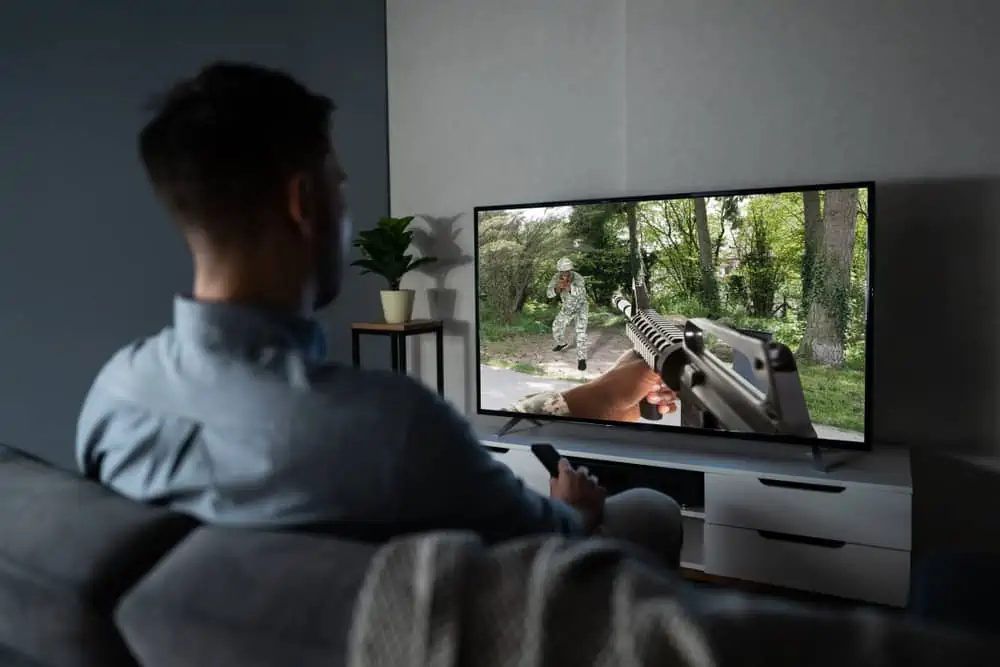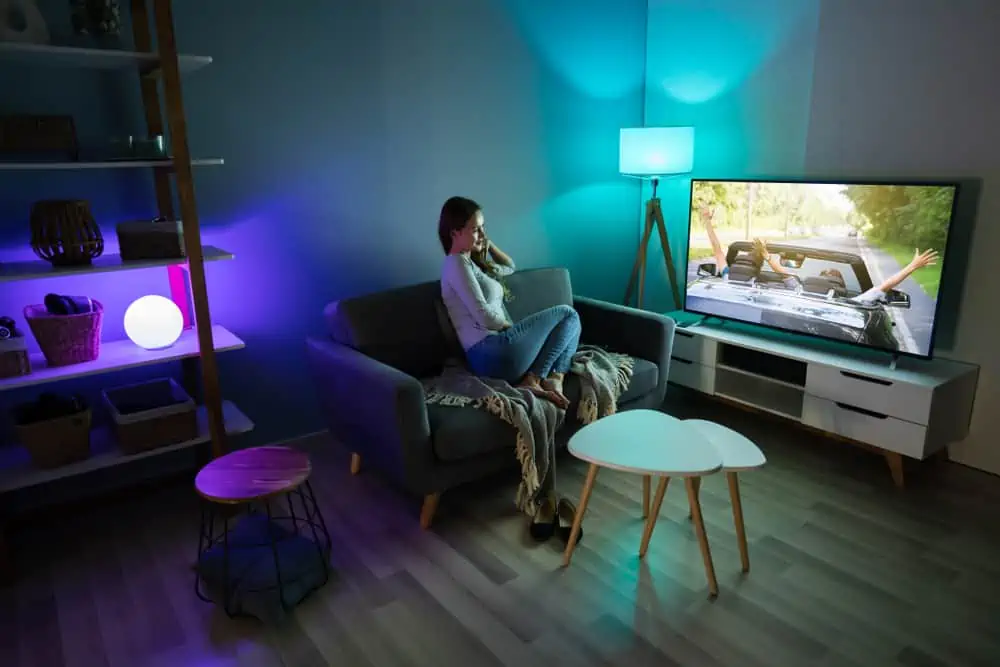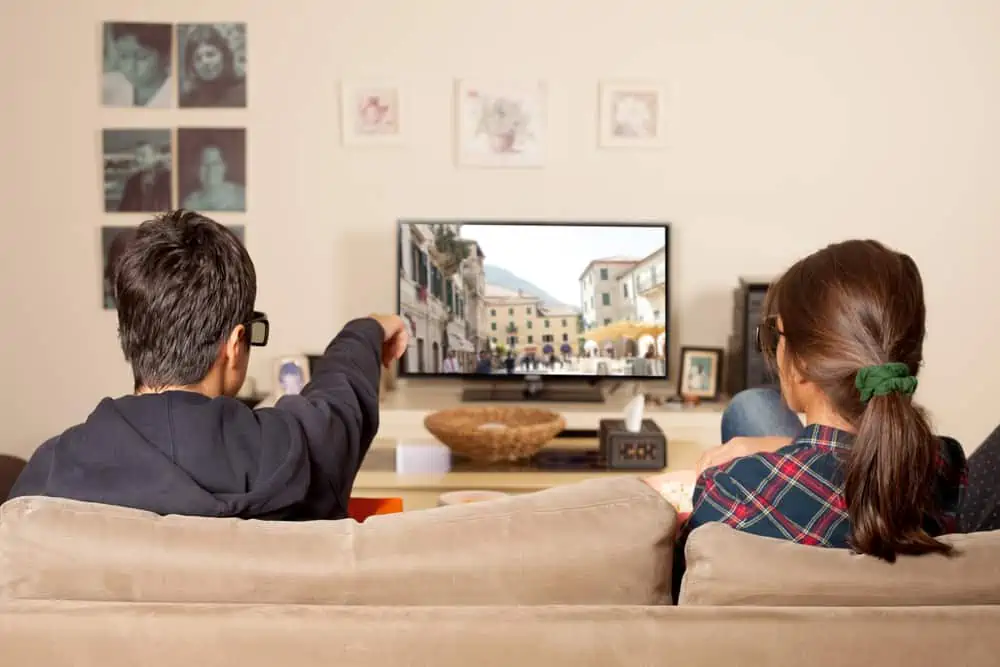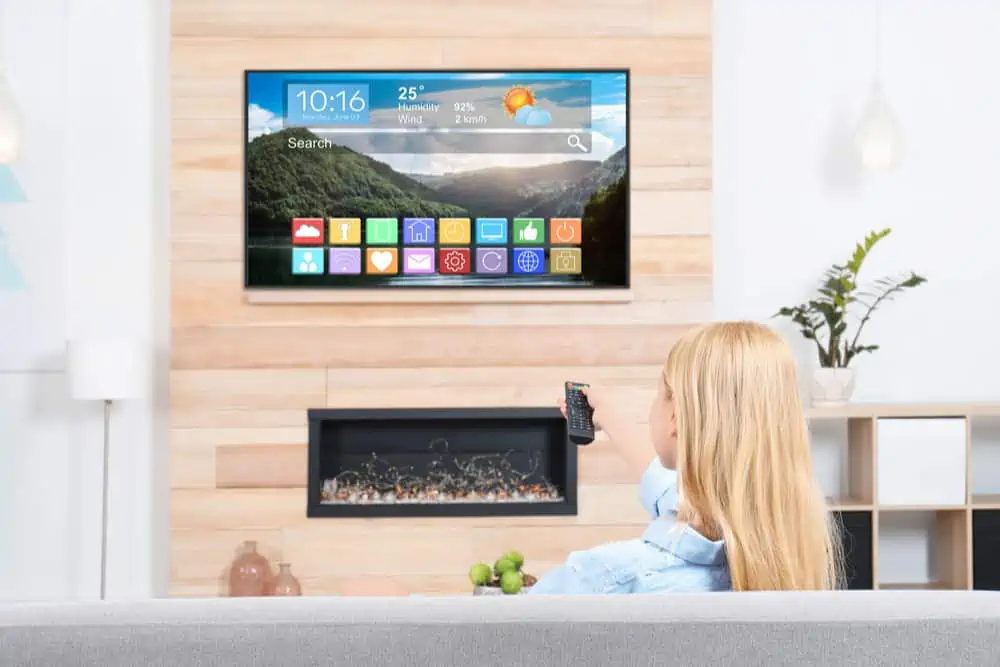Sony X800G: At First Glance
Over time, Sony has continued to prove its worth by manufacturing quality products, one of which is the Sony X800G. The Sony X800G was released in 2019 as the successor to the Sony XF8096, released a year before.
Despite being an entry-level television, the Sony X800G features exciting features, especially the 75-inch models. Specifically, the 75-inch models have features like the X-Reality Pro processor, which improves its performance over the other size models.
Do you wish to know more about the Sony X800G? Then, I suggest you continue reading this article.
Sony X800G: Design, Dimension, and Weight
For the X800G’s design, Sony will probably not be winning any award. This is because there is nothing remarkable about the design of the Sony X800G.
This television has fairly thick bezels with a matte black finish bordering its 4K resolution display. The bezels are plastic-built, but they aren’t flimsy.
Moving to the television’s rear, the Sony X800G has a rather plain back view which is almost identical to that of the Sony X830F. The backplate of the Sony X800G is made of plastic and metal panels.
There is also a glossy black line that makes a break across the middle of the TV’s back. Additionally, the connection panels (units that hold a group of ports) are located on the right side of the television’s rear.
The connection panels are in three sets, with some facing sideways, some facing backward, and some downwards. Based on the nature of this TV’s back, there won’t be much tidy connection cable setup.
This is because the Sony X800G doesn’t feature a cable management feature. Progressing to the stand, the Sony X800G has plastic Y-shaped legs.
Speaking of the legs, the front part is a metallic tint, while the back part is black. Additionally, the Sony X800G legs are hollow at the back part and can help with cable management.
The legs span the almost full length of the Sony X800G and support the TV firmly. However, the TV might still wobble if you exert an external force.
Aside from using the stand, you can alternatively mount the Sony X800G on the wall. However, because of its thickness, it might bulge a bit, and accessing ports might be difficult.
In terms of dimension, the Sony X800G measures 1686 x 80 x 970 mm (W x D x H). This implies that it is not a portable TV.
In addition to its huge size, this TV also weighs 30700 g which makes it bulkier. Comparatively, the Samsung RU7100 weighs lighter than the Sony X800G.
Specifically, the Samsung RU7100 weighs 13607.8 g.
In conclusion, the appearance of the Sony X800G passes off as being boring. Aside from the stand, there is nothing else interesting about its looks.
Hence, I’ll be rating it a seven in this section.
Sony X800G: Display Features and Picture Quality
The display performance of the Sony X800G is quite fascinating. Interestingly, this television is available in five distinct sizes.
Speaking of the display sizes, there is 43″, 49″, 55″, 65″, and 75”. However, my review unit boasts a 75-inch LCD display.
Since this is the largest screen size available for the Sony X800G, viewing content on it will be more comforting to the eye. This is because users won’t have to strain their eyes, thanks to its 75-inch broad screen.
Sony, as a brand, puts a lot of effort into ensuring that its television products deliver quality images. Therefore, Sony has engineered some processor chips to improve performance.
These processors include the X-Reality Pro, Simple X1 processors, Extreme X1 processors, and Ultimate X1. All these processors have special individual-grade processing capabilities.
One of the processors in the Sony X800 G is the X-Reality Pro. The X-Reality Pro allows the TV to display crisp and clear pictures.
In addition to that, the X-Reality Pro technology works more like an upscaler. Therefore, since the Sony X800G resolution is 4K UHD (3840 x 2160), the technology improves HD content to look more realistic.
The X-Reality Pro is able to achieve this feat with the help of an intelligent database and algorithms. With these, the processor is able to make adjustments to different aspects of an image.
Specifically, the X-Reality Pro is capable of adjusting the contrast, color, noise levels, and, more importantly, brightness. Speaking of brightness, the Sony X800G has a peak brightness of 343 nits.
Considering the average peak brightness is over 700 nits, this television’s brightness is relatively poor. Therefore, watching movies in a room with moderate lighting might be the best option.
In addition to its poor brightness, this TV also has a mediocre contrast ratio of 977:1. This is way below the standard contrast ratio of 3000:1.
For better understanding, let’s discuss what contrast ratio means. Contrast ratio is the proportion of whites to black on a screen, which contributes to the picture quality.
Due to the mediocre contrast ratio of the Sony X800G, dark scenes in movies won’t look very dark.
Another downside to the Sony X800G display is that it doesn’t have a local dimming feature. Local dimming is a technology that enhances the black portions of a television.
With sufficient support for local dimming on a display, the black portions on the display should become darker. Unfortunately, that’s not the case for the Sony X800G.
On a brighter note, the Sony X800G features High Dynamic Range (HDR) technology. The HDR format allows for improvements in brightness, high contrast, and a wider range of colors.
For clarity, HDR (High Dynamic Range) is the ratio of light tones to dark tones in an image. Thankfully, this display comes with advanced HDR formats, Dolby HDR and HDR10.
These advanced formats further boost brightness, increase color accuracy, and deepen contrast depending on what you are watching. Therefore, streaming HDR content from the likes of Netflix will give you a full experience of the HDR format.
Furthermore, the viewing angles of the 75-inch Sony X800G are good. This is because only the 75-inch display option has a VA panel which improves its viewing angles.
Thus, the viewing angle on the other display size options might be terrible. However, with the decent viewing angles on the 75-inch Sony X800G, there will be no problem watching content from an angle.
In addition to excellent viewing angles, in terms of reflection handling, the Sony X800G’s display handles reflection well. This is because the display has a semi-gloss coating.
This semi-gloss coating helps to absorb a significant amount of reflection. Hence, making the display fit for moderately lit environments.
The Sony X800G further exhibits a wide color coverage on the color gamut test. This television measured 91.6%, which is a fantastic score.
In terms of motion performance, we’ve noticed a great deal of consistency in Sony’s budget-friendly, entry-level, and top-tier laptop models. However, let’s confirm if the Sony X800G follows this trend.
To do that, let’s see how well it fared in its response time test. The Sony X800G measured a response time of 14.6 ms.
For better understanding, response time determines the clarity of motion content. Thus, for response time greater than 24ms, the images might begin to get blurry.
Although a lower response time means better, the 14.6 ms recorded by the Sony X800G is good enough. Therefore, this TV is suitable for watching fast-moving content.
Furthermore, the Sony X800G has a decent refresh rate of 60Hz. Refresh rate refers to how often a display updates its content in a second.
Next up, let’s look at the input lag test. From this test, the Sony X800G achieved a score of 34.5ms.
For clarity, input lag is the delay between an input signal and the reaction on the display. Meanwhile, a lower input lag means better.
That being said, the 34.5ms input lag achieved by the Sony X800G is unimpressive. Moreover, it exceeds the 15ms recommended input lag for gamers.
In conclusion, the display properties of the Sony X800G are not remarkable. Its peak brightness isn’t so great, and it has no local dimming.
However, the HDR technology should make up for some of these flaws. Therefore, having assessed this section of the Sony X800G review, I will be rating this TV a seven out of ten.
Sony X800G: Sound Features
For its sound feature, the Sony X800G boasts 2 channel 20 watts speakers. The 20 watts speaker features a bass reflex or ported systems that enhance the replication of low frequencies.
In simpler terms, the Sony X800G speaker has little vents that project low frequencies. This enables the speaker to produce loud sounds but with flatter bass.
Hence, we shouldn’t expect an outstanding performance from the Sony X800 G’s speaker. Moreover, if you are hoping to get some thumping and immersive sounds, you might need to get a soundbar for that.
However, dialogue clarity on the Sony X800G is at its best. Therefore, users can get the best when watching talk shows, news, and sports.
The Sony X800G also offers some audio features, which include the ClearAudio+ and the S-Force Front Surround.
Firstly, the ClearAudio+ technology automatically adjusts the television’s audio to suit the content you are watching. This helps the sound system to offer the best acoustic results.
The second technology that the Sony X800G sound system supports is the S-Force Front Surround. This feature emulates a 3D acoustic surround, thereby giving a 360 degrees theater-like sound.
In addition to that, the Sony X800G can get relatively loud. Unfortunately, its total harmonic distortion (THD) numbers get extremely high at maximum volume.
To further explain the above terms, total harmonic distortion is the measurement of changes in sound production. Therefore, in the THD test, the Sony X800G measured distortion of 0.105 at 80dB, but the number went up at MAX dB to 14.5.
In conclusion, the Sony X800G sound unit’s performance is passable. However, it might not be fit for gamers.
Thus, I will be rating the Sony X800G a six in this section.
Sony X800G: Ports and Connectivity Features
The Sony X800G features a reasonable number of ports. Its ports panels are in three connection panels (units that hold a group of ports), positioned to the right side of the television’s back.
The Sony X800G has a unique arrangement of its ports. For instance, some of the ports face backward, some face sideways to the right, and others face downwards.
Therefore, we will be discussing the ports based on these groupings. Firstly, the panel facing backward houses four ports – a digital audio output, a 3.5 mm headphone jack, and two HDMI ports.
The second group of ports is those facing sideways which can easily be accessed when the TV is wall-mounted. These ports include two USB 2.0 outlets for connecting an external device.
Surprisingly, the Sony X800G came with an additional USB 3.0 port. Frankly, I didn’t see that coming because even some expensive TV models do not come with a USB 3.0.
Still, on the side-facing group of ports, you will also get two HDMI ports, one of which is ARC compatible. There is also get a cable port among the side-facing group of ports.
Lastly, the third group is unique as it harbors a couple of ports that face downwards. This group of ports features a composite input port, an IR blaster port, and an Ethernet port for wired internet connectivity.
Speaking of internet connectivity, the Sony X800G comes with in-built WiFi for wireless internet connectivity. In addition to that, it also has Bluetooth, version 4.1.
The Sony X800G also comes with remote control. Unfortunately, the remote isn’t a smart one and requires a direct sightline to send commands on the TV.
The Sony X800G remote also features partial Bluetooth connectivity, but only for voice control. It would have been a lot better if Sony integrated full Bluetooth for the remote.
That would have been much easier instead of having to point at the TV every time you use the remote.
Moving on to the looks and functions of the Sony X800G remote, of course, there aren’t many special features. But, to give more details, there are three big round buttons at the upper part of the remote.
From the right, you will find the power button, the voice interaction button, and the button for input selection. The numerical button is below this set of buttons, followed by two quick-access buttons for launching Netflix and Google play.
Further below the access buttons are the smart buttons. Meanwhile, you will find the navigation buttons in the middle of the remote.
You will get the volume control to the left and channels control to the right below the navigational buttons.
Lastly, you will find the playback buttons at the bottom of the remote. Meanwhile, the Sony logo is just below the playback buttons.
I can’t say whether or not I am excited about the Sony X800G remote features. However, it functions efficiently and should serve its purpose.
However, the Sony X800G has remarkably rich ports and connectivity collections. Hence, I’ll be rating the Sony X800G an eight in this section of the review.
Sony X800G: Smart Features
The Sony X800G features an Android platform for its smart functions, which is exciting. However, what is more exciting is that it came with an updated Android version.
Having said that, the Sony X800G features Android version 8 Oreo. This Android version is relatively smooth, and there has been positive feedback concerning the improvements over older versions.
However, it is still not enough to say that the Android OS is at its best yet. Considering the competition, Android has a lot of catching up to do.
However, I believe that this update is a step towards better improvements. Speaking of progress, the Android 8 Oreo on the Sony X800G feels much smoother and easier.
We also get newer layouts for better navigation on the interface. Additionally, some streaming apps at the bottom of the interface have been moved to the top.
Generally, the overall performance of the operating system has improved significantly. Also, navigating different services and features is seemingly effortless.
Furthermore, the previous Android version was unable to make intelligent suggestions based on the content usually searched. Nevertheless, the issue has been fixed on the Android version 8 Oreo.
Still, on the improvements, this Android version also had huge development on its support library – Google Play.
Additionally, the Sony X800G has some pre-installed streaming services on its interface. Pre-installed apps you can find include Netflix, Amazon Prime, YouTube, Google Play, and more.
Users can also source more apps and services via the Android Playstore if the ones pre-installed are not enough. I should also mention that playing HDR content is also supported on Netflix and YouTube.
Furthermore, the Sony X800G has an in-built Chromecast that aids streaming from mobile phones or tablets to the TV.
The Sony X800G smart function doesn’t end there, the television also has a voice control feature. However, the voice control feature has its limitations.
Alternatively, Sony has also created a remote app that you can install on your smartphone and control the TV that way. The app is pretty good, although we can admit that functionality is a bit limited as you cannot access the TV’s settings with it or input text in certain streaming platforms.
However, as an alternative, the remote’s main commands is a valid option.
Furthermore, the Sony X800G also has an in-built media player for playing content from external storage devices. Unfortunately, it doesn’t support AirPlay2 or Apple TV.
To conclude this section, the Sony X800G improved Android platform is quite interesting. As a result, I will be rating the Sony X800G an eight in this smart feature review section.
Frequently Asked Questions
The Sony X800G is quite an impressive 4K resolution smart television with good display qualities. Also, the number of ports it offers is commendable.
However, the Sony X800G has inadequate brightness, and its local dimming feature is also lacking.
Yes, the Sony X800G comes with Bluetooth version 4.1.
Sort off. The Sony X800G measured a response time of 14.6 ms. Impressively this response time is good enough for watching fast-moving content and playing video games.
Unfortunately, this Sony TV’s input lag of 34.5ms is more than twice the recommended value of 15ms suitable for gamers.
The Sony X800G has a peak brightness of 343 nits. Considering the peak brightness standard of over 700 nits, this television’s brightness is relatively poor.
Only the 75-inch display option of the Sony X800G features a VA panel. Hence, the 43-inch, 49-inch, 55-inch, and 65-inch display options lack a VA panel.
Therefore, the viewings angle might be terrible on the display options without a VA panel.
Conclusion
The Sony X800G is a good, smart TV with an admirable 4K resolution display. Moreover, this TV can deliver quality pictures, thanks to the HDR10 format and the X-Reality Pro processor.
Additionally, this TV has a good number of ports to meet users’ connectivity needs. Also, the Android operating system that the Sony X800G uses features significant improvements from previous Android versions.
However, the Sony X800G recorded some setbacks in its brightness level and local dimming. Nonetheless, the overall features and performance of this TV are decent.
Hence, if you are interested in Sony TVs, the Sony X800G might be an exciting choice.
I hope you found this Sony X800G review helpful. If it was helpful, Kindly spare two minutes to share your thoughts with our community using the comments form below.
Alternatively, simply respond to the “Was this page helpful” question below and provide us with your feedback.
For more Television reviews, visit our Television review page. You may also find our Television Specs page very helpful.



